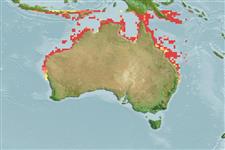Actinopterygii (ray-finned fishes) >
Perciformes (Perch-likes) >
Sillaginidae (Smelt-whitings)
Etymology: Sillago: From a locality in Australia . More on author: Whitley.
Environment / Climate / Range
Ecology
Marine; brackish; demersal; non-migratory; depth range 0 - 10 m (Ref. 6205). Tropical, preferred ?; 8°S - 30°S, 110°E - 157°E (Ref. 6205)
Western Central Pacific: northern Australia, from Shark Bay, Western Australia to Moreton Bay, Queensland. Also known from the southern coast of New Guinea. Sillago nierstraszi is almost certainly a synonym of this species.
Size / Weight / Age
Maturity: Lm ? range ? - ? cm
Max length : 45.0 cm SL male/unsexed; (Ref. 6205); common length : 35.0 cm SL male/unsexed; (Ref. 9679)
Dorsal
spines
(total): 12;
Dorsal
soft rays
(total): 16-18;
Anal
spines: 2;
Anal
soft rays: 14 - 17;
Vertebrae: 33 - 34. The shape of the swim bladder is not distinguishable from that of S. ciliata. The anterior part of the swim bladder has rudimentary tubules projecting anteriorly and a lateral series, that diminishes in size and becoming sawtooth-like, projecting posteriorly. Body is light silvery, slightly darker to dusky dorsally. A dull golden silver to golden yellow stripe is below the lateral line. The pelvic and anal fins are pale yellow to bright yellow; the pectoral fin has a darker dusting of fine black-brown spots.
Juveniles of this species, together with those of S. schomburgkii remain in warm waters of the shallow mangrove creek shorelines and protected inlets. Mature S. analis prefer the muddy, tidal streams. The preferred prey are crustaceans. They also rummage in the silty-sand substrates for worms and have been observed to 'plough' up the bottom with the snout (Ref. 6205). Oviparous (Ref. 205).
Life cycle and mating behavior
Maturity | Reproduction | Spawning | Eggs | Fecundity | Larvae
McKay, R.J., 1992. FAO Species Catalogue. Vol. 14. Sillaginid fishes of the world (family Sillaginidae). An annotated and illustrated catalogue of the sillago, smelt or Indo-Pacific whiting species known to date. Rome: FAO. FAO Fish. Synop. 125(14):87p. (Ref. 6205)
IUCN Red List Status (Ref. 115185)
CITES (Ref. 94142)
Not Evaluated
Threat to humans
Harmless
Human uses
Fisheries: commercial; aquaculture: likely future use
More information
Common namesSynonymsMetabolismPredatorsEcotoxicologyReproductionMaturitySpawningFecundityEggsEgg development
ReferencesAquacultureAquaculture profileStrainsGeneticsAllele frequenciesHeritabilityDiseasesProcessingMass conversion
Tools
Special reports
Download XML
Internet sources
